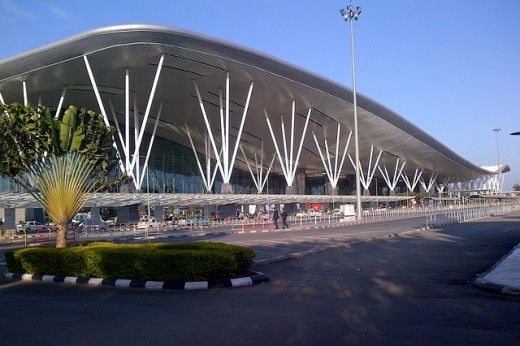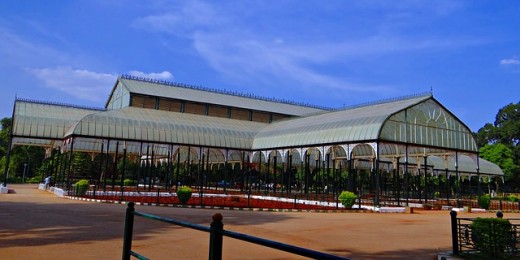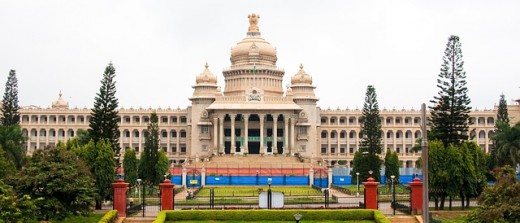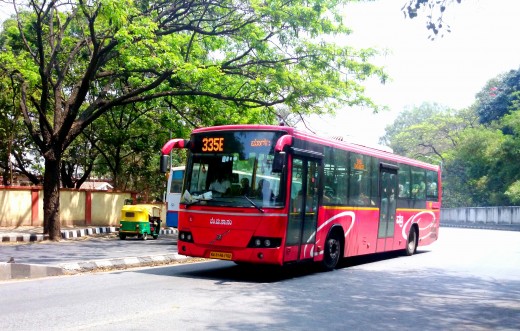Bengaluru Is a Developed, Progressive and Wonderful City
Tourists from all over the world visit Bengaluru because this developed, progressive and wonderful city offers many attractions for old and young alike. Over the years Bengaluru has been known by various sobriquets, including Garden City of India, Silicon Valley of India, Pensioners' Paradise, IT capital of India and Pub city.
How to Reach Bengaluru
Bengaluru has an international airport, railway stations and bus stations. It is an extremely well-connected city.
The Kempegowda International Airport, which is located around 40 km north of the city, handles more than 22 million passengers annually. Many major airlines operate flights to Bengaluru from prominent cities worldwide,
Kempegowda International Airport

Krantivira Sangolli Rayanna Railway Station
Formerly known as Bangalore City railway station, this is the main railway station of Bengaluru. It handles more than 80 trains daily.
Kempegowda Bus Station
Popularly known as Majestic, this large bus station in central Bengaluru is the main bus station of the city. It is located opposite Krantivira Sangolli Rayanna railway station.
Here are the top tourist destinations in Bengaluru
Here are some places to visit in Bangalore. Visit to these locations is an entertaining and enriching experience.
Cubbon Park
Located at the heart of the city, this historic park covers an area of around 100 acres. It has around 68 genera and 96 species with a total of around 6000 plants / trees. Jawar Bal Bhavan, aquarium and Indira Priyadarshini Children’s Library are some attractions in the park.
Bull Temple
Known as Dodda Basavana Gudi, this temple is located in Bugle Rock park. A large granite Nandi monolith is placed on a plinth in the temple shrine. This small temple is in Vijayanagara architecture style.
Bannerghatta Biological Park
Part of the Bannerghatta National Park, this biological park offers various opportunities for education and entertainment, including zoo, butterfly park, boating, safari and aquarium.
Shiva Temple
This beautiful temple houses a 65-feet-tall statue of Lord Shiva in lotus posture. The statue is carved out of white marble. It is located in Murugeshpalya, Old Airport Road.
Lalbagh Botanical Gardens
Covering an area of 240 acres, this beautiful botanical garden houses India's largest collection of tropical plants. It has more than 1,000 species of flora. Glass House, Statue of Sri Chamaraja Wodeyar, lake and floral clock are some locations of interest in Lalbagh.

Visvesvaraya Industrial and Technological Museum
Established in memory of Bharat Ratna Sir M Visvesvaraya, this museum is a techie's delight. It has seven exhibition halls: Engine Hall - How Things Work, Electrotechnic, Fun Science, Space-Emerging Technology in the Service of Mankind, Biotechnological Revolution, BEL-Hall of Electronics and Science for Children.
Wonderla Amusement Park
This top-rated amusement park offers you and your loved ones many opportunities for fun and entertainment. It is well-known for its exciting water rides and land rides.
SRCM Heartfulness Meditation Centre
Located in Banashankari 2nd Stage, this serene meditation center attracts people who seek to refine themselves, to evolve, to grow spiritually. I learnt to meditate here and visit this Ashram at least once a week. Group meditation is held on Sundays and Wednesdays.
Innovative Film City Movie Studio and Amusement Park
You can expect plenty of fun and entertainment at Innovative Film City. Aqua Kingdom, Cartoon City, Dino Park, Mini Golf and Mirror Maze are among its main attractions.
Jawaharlal Nehru Planetarium
Located at the heart of the city, the Jawaharlal Nehru Planetarium houses a planetarium, a science park and a science center. The planetarium can seat 210 people.
ISKCON Temple
Built in 1997, the International Society for Krishna Consciousness (ISKCON) temple is a huge cultural complex. It is located on the Hare Krishna Hill in Rajajinagar.
Bangalore Palace
Bangalore Palace was built in Tudor style architecture. This majestic palace is enclosed by beautiful gardens. The complex, including the gardens, covers an area of about 454 acres.
It is well-known for its superb carvings, Gothic-style stained-glass windows, floral motifs, cornices, stained mirrors, blue-coloured fluorescent ceramic tiles, Victorian, neo-classical and Edwardian style furniture and Raja Ravi Verma paintings.
Vidhana Soudha
Vidhana Soudha is the seat of the state legislature of Karnataka. This magnificent building is an example of neo-Dravidian architecture.

St. Mary's Basilica
This Catholic church is located in the Archdiocese of Bangalore. Consecrated in 1882, it is built in the Gothic style with arches, ornamental motifs and stained glass windows.
Phoenix Marketcity
With a total retail floor area of 1,400,000 square feet, it is the largest mall in Bengaluru by area. Here you will find more than 270 stores, a food court, a 9-screen PVR Cinemas multiplex and much more.
Ulsoor Lake
Located in East Bengaluru, this lake has a surface area of around 124 acres. Boating is a major activity in this lake, which has beautiful islands. You will find many beautiful flowers and birds here.
UB City
Covering an area of 13 acres, UB City is the biggest luxury commercial property project in Bengaluru. In fact it is India's first luxury mall. Located in the CBD area of the city, UB City houses commercial offices, banks, high-end retail stores, a five star hotel, serviced apartments, restaurants, food courts, pubs, health clubs and cafes.
Ragigudda Anjaneya Temple
Located in South Bengaluru, this serene temple is dedicated to Lord Hanuman. Built in 1969 by a group of young devotees, this temple is located on a hillock. The temple complex covers an area of around five acres. I have been visiting this temple since 1980s.
Infant Jesus Church
Established in 1971, this Roman Catholic Church is located in Vivek Nagar. The church has a fan-shaped hall and can accommodate around 2,500 people.
Param Dham
Param Dham means Divine Abode. This meditation center is well-known for its serene atmosphere that nurtures your soul.
Dodda Alada Mara
Located near Kengeri, Dodda Alada Mara, which means big banyan tree (Ficus bengalensis), is a giant 400-year-old tree. It covers an area of around three acres.
SRCM Bengaluru Zonal Ashram
You need to visit this Ashram for its unique, subtle, calm and serene atmosphere.
Hotels in Bengaluru
There are many 5-star hotels, mid-range hotels and budget hotels in Bengaluru.
Star Hotels
- The Lalit Ashok Bangalore
- The Ritz-Carlton
- Hyatt
- Hotel Grand Mercure
- Le Méridien Bangalore
Budget Hotels
- The Signature Inn
- UG Regal
- Ginger Hotel
- Hotel T.A.P. Silver Square
- Hotel SNT Comforts
Hotels in Bangalore
5-Star Hotel
|
4-Star Hotel
|
3-Star Hotel
|
2-Star Hotel
|
1-Star Hotel
|
|---|---|---|---|---|
The Lalit Ashok Bangalore
|
The Capitol Hotel
|
The Bell Hotel and Convention Centre
|
Hotel T.A.P. Silver Square
|
UG Regal
|
The Ritz-Carlton
|
The Pride Hotel Bangalore
|
Hotel Bangalore Gate
|
Hotel Swagath
| |
Le Méridien Bangalore
|
The Gateway Hotel
|
Hotel Abhimaani Vasathi
|
Mel's Regency Hotel
|
Transportation
Bus
|
Cab
|
Others
|
|---|---|---|
BMTC
|
Ola
|
Namma Metro
|
Uber
|
Auto rickshaw
|
Bengaluru offers various affordable transportation options.
A BMTC Bus

Safety Tips
- Guard your personal belongings.
- Avoid wandering around after 9 pm.
- If you intend to use rickshaw you should inquire about fares and negotiate agreements before getting into the vehicle.
- Beware of pickpockets.
- Avoid roadside food.
Geography and Environment
Located at the heart of the Mysore Plateau, Bengaluru is a landlocked city. Its position is 12.97° N 77.56° E. The average elevation is around 900 meters.
Currently, Kaveri river provides around 80 percent of the total water supply to the city, with the remaining 20 percent being obtained from the Thippagondanahalli and Hesaraghatta reservoirs of the Arkavathi river. The city receives 800 million liters of water daily.
A random sampling study of the Air Quality Index of twenty stations within the city indicated scores that ranged from 76 to 314. This suggests heavy to severe air pollution around areas of traffic concentration.
Madivala tank, Hebbal lake, Ulsoor lake and Sankey Tank are some freshwater lakes in the city. Groundwater occurs in silty to sandy layers of the alluvial sediments.
The Peninsular Gneissic Complex is the most dominant rock unit in the region. It includes granites, gneisses and migmatites, while the soils of Bangalore consist of red laterite and red, fine loamy to clayey soils.
Vegetation in the city is primarily in the form of large deciduous canopy and minority coconut trees. Though Bangalore has been classified as a part of the seismic zone III.
Bengaluru has two unique topography terrains: North Bangalore taluk and South Bangalore taluk. The North Bangalore taluk is relatively more level plateau and lies between an average of 839 to 962 meters above sea level.
The middle of the taluk has a prominent ridge running NNE-SSW. The highest point in the city, Doddabettahalli, (962m) is on this ridge. There are gentle slopes and valleys on either side of this ridge. The low-lying area is marked by a series of water tanks varying in size from a small pond to those of considerable extent, but all fairly shallow.
The South Bangalore taluk has an uneven landscape with intermingling hills and valleys. The southern and western parts of the city consist of a topology of granite and gneissic masses. The eastern portion is a plane, with rare minor undulations.
Climate
Bengaluru has a tropical climate. Summers are rainier than winters. The city's climate is categotized as Aw as per the Köppen-Geiger climate classification. The average temperature is 23.6 °C. Annual average rainfall is 831 mm.
With a rainfall of 1 mm, January is the driest month. Precipitation is highest (182 mm average) in September. April is the warmest month of the year, when the average temperature is 27.1 °C. December is the coldest month of the year; the average temperature is around 20.7 °C. There is a difference of 181 mm of precipitation between the driest and wettest months. The variation in temperatures throughout the year is 6.4 °C.
History of Bengaluru
- The earliest reference to the name "Bengalūru" was found in a 9th-century Western Ganga Dynasty stone inscription on a "vīra gallu, which means "hero stone", a rock edict extolling the virtues of a warrior. In this inscription found in Begur, "Bengalūrū" is referred to as a location in which a battle was fought in 890 CE. It states that the place was part of the Ganga Kingdom until 1004 and was known as "Bengaval-uru", the "City of Guards" in Old Kannada.
- An apocryphal story recounts that Veera Ballala II, a 12th century Hoysala king, while on a hunting expedition, lost his way in the jungle. Fatigued and famished, he came across a poor old lady, who served him boiled beans. The grateful ruler named the place "benda-kaal-uru" (a Kannada term which means, town of boiled beans). Bendakaaluru eventually evolved into Bengaluru.
- Discovery of Stone Age artefacts in 2001 at the outskirts of the city, suggest probable human settlement around 4,000 BCE.
- The Chokkanathaswamy temple at Domlur, the Aigandapura complex near Hesaraghatta, Mukthi Natheshwara Temple at Binnamangala, Choleshwara Temple at Begur, Someshwara Temple at Madiwala, date from the Chola era.
- Modern Bengaluru was begun in 1537 by Kempe Gowda I, a feudatory of the Vijayanagara Empire. He built a mud-brick fort for the people at the site that would become the central part of modern Bengaluru.
- During the Vijayanagara rule, many saints and poets referred to Bengaluru as "Devarāyanagara" and "Kalyānapura" or "Kalyānapuri", a Kannada term which means auspicious city.
- Hyder Ali and Tipu Sultan contributed towards the beautification of Bengaluru by building Lal Bagh Botanical Gardens in 1760. Under them, the city developed into a commercial and military centre of strategic importance.
- The British found Bengaluru to be a pleasant and appropriate place to station their garrison. They moved their cantonment to the city from Seringapatam in 1809 near Halsur (Ulsoor). A town developed around the cantonment by absorbing many villages in the area. The new centre had its own municipal and administrative apparatus, though technically it was a British enclave within the territory of the Wodeyar Kings of the Princely State of Mysore.
- Two significant developments that contributed to the rapid growth of Bengaluru include the introduction of telegraph connections to all major Indian cities in 1853 and a rail connection to Madras (Chennai) in 1864.
- In the nineteenth century, Bengaluru essentially became a twin city, with the "pētē", whose residents were predominantly Kannadigas and the cantonment created by the British. Throughout the nineteenth century, the Cantonment gradually expanded and acquired a distinct cultural and political salience as it was governed directly by the British and was known as the Civil and Military Station of the city. While it remained in the princely territory of Mysore, Cantonment had a large military presence and a cosmopolitan civilian population that came from outside the princely state of Mysore, including British and Anglo-Indians army officers.
- Bengaluru was hit by plague in 1898. It killed nearly 3,500 people. The crisis caused by the outbreak of the disease catalysed the city's sanitation process. Telephone lines were laid to help co-ordinate anti-plague operations. Regulations for building new houses with proper sanitation facilities came into effect.
- Victoria Hospital was inaugurated in 1900 by Lord Curzon, the then Governor-General of British India.
- Motor vehicles came to be introduced in the city in 1903.
- In 1906, Bengaluru became one of the first Indian cities to have electricity from hydro power, powered by the hydroelectric plant located in Shivanasamudra.
- The Indian Institute of Science was established in 1909, which subsequently played a major role in developing the city as a science research hub.
- In 1912, the Bangalore torpedo, a defensive explosive weapon widely used in the First World War and the Second World War, was devised in the city by British army officer Captain McClintock of the Madras Sappers and Miners.
- Bangalore's reputation as the "Garden City of India" began in 1927 with the Silver Jubilee celebrations of the rule of Krishnaraja Wodeyar IV. Many projects, like the construction of parks, public buildings and hospitals, were instituted to improve the city.
- Bengaluru played a significant role during the Indian independence movement. Gandhiji visited the city in 1927 and 1934 and addressed public meetings.
- In 1940, the first flight between Bengaluru and Mumbai took off, thereby placing Bengaluru on the nation's urban map.
- After India's independence in 1947, Bengaluru remained in the newly carved Mysore State of which the Maharaja of Mysore was the Rajapramukh (appointed governor).
- The "City Improvement Trust" was formed in 1945, and in 1949, the "City" and the "Cantonment" merged to form the Bangalore City Corporation. The Government of Karnataka constituted the Bangalore Development Authority in 1976 to co-ordinate the activities of these two bodies.
- Bengaluru experienced rapid growth in the decades 1941–51 and 1971–81, which saw the arrival of many immigrants from northern Karnataka. By 1961, Bangalore had become the sixth largest city in India, with a population of 1,207,000. In the decades that followed, Bangalore's manufacturing base continued to expand with the establishment of private companies such as MICO, which set up its manufacturing plant in the city.
- By the 1980s, urbanisation had spilled over the current boundaries, and in 1986, the Bangalore Metropolitan Region Development Authority, was established to co-ordinate the development of the entire region as a single unit.
- On 8 February 1981, a major fire broke out at Venus Circus in the city. More than 90 lives were lost, the majority of them being children.
- Bengaluru experienced a growth in its real estate market in the 1980s and 1990s, spurred by capital investors from other parts of the nation, who converted the city's large plots and colonial bungalows into multi-storied apartments.
- In 1985, Texas Instruments became the first MNC to set up base in the city. Other IT companies followed suit and by the end of the 20th century, Bengaluru had established itself as the Silicon Valley of India.
Summary
- Bengaluru is an extremely well-connected city.
- Bull Temple is located in Bugle Rock park.
- Bannerghatta Biological Park has a zoo, butterfly park, boating, safari and aquarium.
- The 65-feet-tall Shiva statue in Murugeshpalya is carved out of white marble.
- Lalbagh has more than 1,000 species of flora.
India's prosperity is sectioned by geography, such as in Bangalore, where the information technology industry is prominent. Because they have a conduit out of India, competing in the world by the Internet, it's not regulated in corrupt ways, and it is very prosperous.
— Clayton ChristensenFamous Personalities in Bengaluru
Many experts in the field of medicine (like Dr. Devi Prasad Shetty), scientists (like Krishnaswamy Kasturirangan), politicians (like B. S. Yeddyurappa), writers (like Girish Karnad), entrepreneurs (like N. R. Narayana Murthy), sportspersons (like Robin Uthappa), entertainers (like Sudeep), and spiritual leaders (like Jaggi Vasudev) have made Bengaluru their home.
No comments:
Post a Comment